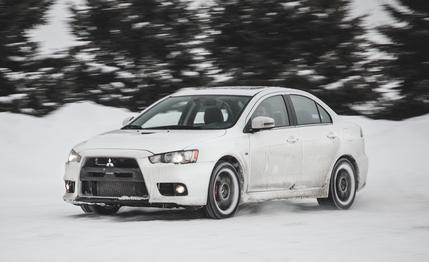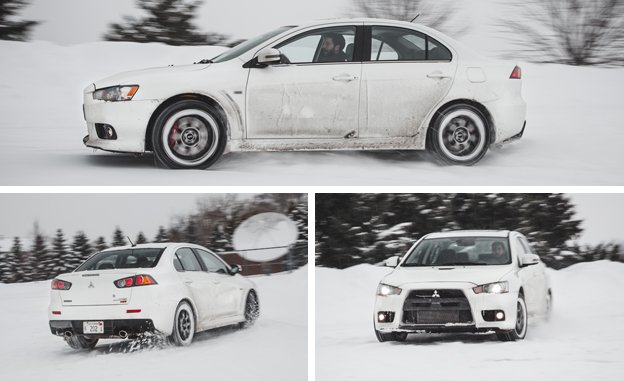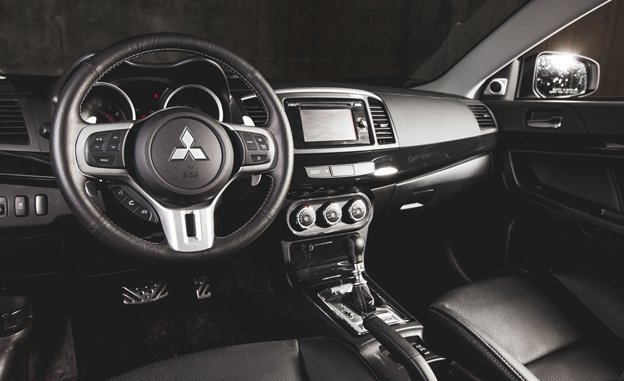 Instrumented Test
Instrumented Test
Rarely is a car’s model name ironic while it is still in production, although there are some exceptions: The Ford Aspire was pretty ironic from the get-go, and the Chevrolet Monte Carlo was rarely seen on the streets of that principality. Which brings us to the Mitsubishi Lancer Evolution X. With “evolution” in its name, one expects it to continually improve, to adapt to its surroundings, and, well, evolve the breed. But we know it’s a dead car rolling. It’s like the last saber-toothed tiger, sadly wandering alone to its final resting place.
And like that ice-age feline, the tenth-generation Evo is a killer capable of dispatching much larger prey. Americans had to wait until the eighth version of the Evo, which finally was legally imported just over a decade ago. With sharp reflexes, a strong turbocharged four, four-wheel drive, and a manual transmission, it won our hearts. For the record: The Evo was undefeated in its three comparison tests, which took place in 2003, 2005, and 2008 and covered the three American Evo generations.

Unfortunately, being based on the pedestrian Lancer compact didn’t do the car any favors. While the Evo was always the sharpest of the pseudo-rally trio (Evo, Subaru WRX STI, and Volkswagen Golf R), giving no quarter to daily life, all Evos suffered from painfully drab interiors. We’re all for spartan interiors with just the right amount of function, but when the plastics and trim in a $40,000 car are so cheap you hesitate to put a date in the passenger seat, sometimes the car doesn’t make all that much sense. To top it all off, for the final year, Mitsubishi isn’t offering the Recaro seats as an option. The snug-fitting buckets in the Evo VIII and IX were benchmarks, not only in their small segment, but across the entire industry. Sure, the X’s Recaros were wider and more accommodating, but they were still very good at keeping a butt planted in the seat. (In 2014, the Recaro seats came as part of a $1900 package in the MR.)
But we didn’t notice the missing Recaros right away. It wasn’t until we took an on-ramp and were slid across the seat by lateral forces that we noticed the missing bolsters. In addition, the stock Lancer saddle raises the H-point (where your hip sits), and you clearly sit on top of this seat, not in it. While it had been a while since we drove an Evo, the model walked away with the title of best-handling car under $40K in 2011. Without those seats, it may not have won, as a good pair of sport seats allow a driver to focus on the task at hand rather than keeping their body in a proper driving position. Fortunately the award-winning chassis didn’t depart with the Recaros in this final model year. The car still handles as well as ever—it just isn’t as enjoyable. It’s a real bummer that the last Evo isn’t the best evolution.
Launch control gets the Evo to 60 mph in 4.9 seconds and through the quarter in 13.7, about the same as every other Evo X MR we’ve tested. When this car came out for 2008, the dual-clutch automatic transmission, torque-vectoring rear differential, and even the launch protocol were genuinely exotic pieces that could be found only in a few other cars, one of those being the R35 Nissan GT-R for well over twice the price.

Aside from the interior, you’d never guess that the Evo shares anything with a front-drive Lancer. Superquick steering reacts to every twitch and likewise sends feedback in amazing fidelity. As long as the turbo is spooled up, the 291-hp 2.0-liter inline-four pulls strongly to redline. And the brakes bite hard and offer excellent modulation, for precise rotation while trail-braking. Evos weren’t meant for traffic—commuting in one amounts to masochistic abuse and brings unbearable frustration with fellow drivers who aren’t as eager to play as you are. Evos are built for tracks, canyons, mountain roads, and, yes, even drag strips.
It is a sad day when we learn of a fun and attainable car getting the ax. Unfortunately, the auto business is driven largely by dollars and not emotion; otherwise we would still have Wankel-engined cars from Mazda and Elises from Lotus. Mitsubishi will take the Evolution’s low-volume, halo-car budget and throw it at appliance-grade commuter vehicles with plug-in-hybrid powertrains, with the hopes of selling thousands more cars. If the Mitsubishis people prefer to buy are to become increasingly boring, we suppose that’s a sort of evolution after all. It just isn’t the Evolution we want.